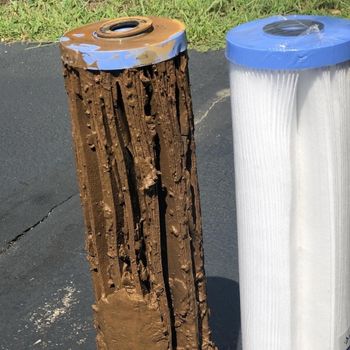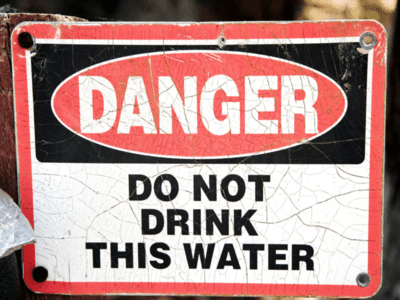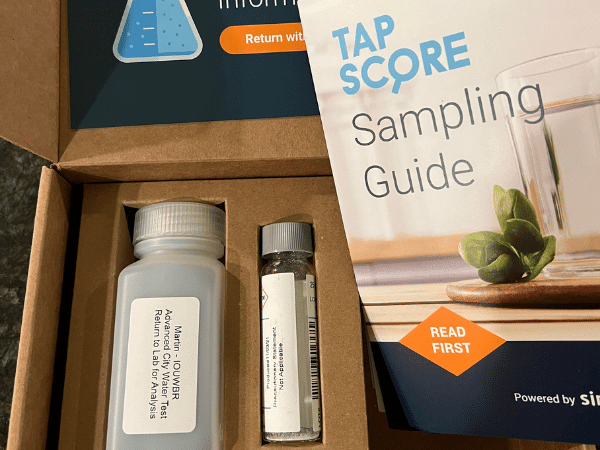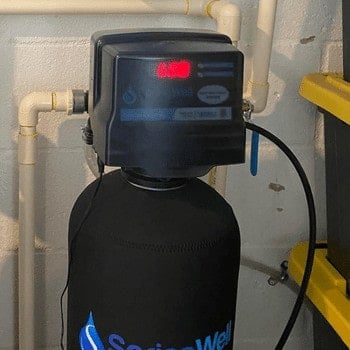If your tap water looks more like tea than something you’d actually drink, you’re not alone — and you’re definitely not stuck with it.
Brown well water usually means there’s something extra swirling around in your supply — iron, silt, tannins, or even bacteria. Some causes are harmless (just ugly), while others can damage plumbing or even impact your health.
The good news? You can fix it. This guide breaks down exactly what causes brown well water — and how to clear it up for good.
⚡ Quick Take
- 🪨 Sediment overload – Dirt, rust, or silt are common culprits
- 🧲 Iron & manganese – Can stain your sinks and taste metallic
- 🦠 Iron bacteria – Slimy and gross, but more of a nuisance than a threat
- 🌿 Tannins – Natural organics that tint water yellow or brown
- 🔬 Testing is critical – Brown water can hide harmful contaminants
- 🧼 Filters can fix it – Choose the right system based on the source
🧪 Why Is My Well Water Brown?

If your water has turned murky, it’s more than just an eyesore — it’s a signal something’s off with your well or plumbing. But before jumping to conclusions, a little troubleshooting can go a long way.
Here’s how to narrow it down 👇
1. 🧼 Start With the Basics
If your water looks brown only when the tap first turns on, then clears? That’s likely rust or sediment in your pipes — especially if your plumbing is older. Try flushing your system or checking your sediment filter.
🛠️ Cold is clear, hot is brown? That points to sediment buildup in your water heater. A simple tank flush could solve it.
2. 🚩 Signs of a Bigger Problem
If the brown water is persistent or affecting both hot and cold taps, your well may be pulling in unwanted contaminants.
Here are the usual suspects:
| 🔍 Cause | ⚠️ What It Looks Like | 📍 Where It Comes From |
|---|---|---|
| 🧲 Iron (Ferric) | Reddish-brown water 🪣 Rust stains on sinks and tubs |
Oxidized iron from rocks or old pipes |
| 🦠 Iron Bacteria | Orange slime in toilet tank 😷 Possible sulfur smell |
Microbes feeding on iron in soil and water |
| 🧪 Manganese | Dark brown or black streaks 🩸 Metallic taste |
Often found with iron near mining regions |
| 🌫️ Silt or Mud | Gritty feel 🌪️ Visible dirt or sediment in water |
Seeps through cracked casings or worn well screens |
| 🍂 Tannins | Yellow-brown tint 🍵 Bitter or earthy flavor |
Decaying vegetation near shallow wells or wetlands |
💡 Pro Tip: If your brown water only appears after heavy rain or snowmelt, your well casing might be compromised. That’s a red flag worth checking right away.
☣️ Is Brown Water Dangerous?

That murky brown water might look rustic, but don’t assume it’s harmless.
In some cases, it’s just annoying (think: rust flakes or plant tannins). In others? It could be hiding something more serious — like harmful bacteria or high iron concentrations that wear down your plumbing and appliances.
Here’s what you need to know 👇
🚩 When It’s Mostly a Nuisance
- Rust and iron can stain sinks, tubs, clothes, and even your hair.
- Sediment and silt may scratch pipes and damage water heaters.
- Manganese might leave black or brown streaks around your fixtures.
None of these are toxic at low levels — but they’ll wear out your plumbing and patience fast.
⚠️ When It’s Potentially Risky
Some brown water isn’t just ugly — it can create the perfect hiding spot for dangerous contaminants.
- Iron bacteria isn’t directly harmful, but it may signal the presence of other microbes that are — including coliform or even E. coli.
- Cloudy water full of particles can shield bacteria from disinfection — especially if you’re using UV.
- Organic material, like silt or tannins, may carry runoff from fields or septic systems.
💡 Pro Tip: Never assume your well water is “safe because it always has been.” If your water suddenly turns brown or starts smelling funky, it’s time to test it. The CDC recommends testing annually, or immediately if you notice changes in color, taste, or odor.
🧪 Determine the Culprit – Test Your Well Water

If your well water’s turned brown, don’t guess — test.
Unlike city water, you’re 100% responsible for monitoring your private well. And brown water, even if temporary, can signal deeper issues that only a proper test can confirm.
Here’s how to get clarity 👇
🔬 What to Test For (According to the CDC)
Per CDC recommendations, private wells should be tested at least once a year for:
- Coliform bacteria
- Nitrates
- pH
- Total Dissolved Solids (TDS) ➡️ Want to learn more? Here’s how a TDS meter works, and why it’s not always the full picture.
Some states also recommend checking for region-specific risks — like arsenic or radon in the Northeast.
🧪 When Should I Test?
Besides your annual check, test your well water:
- After a flood or heavy rainfall
- If you’ve repaired the casing or replaced your well pump
- Whenever water changes color, taste, or smell
🧠 Not sure how to start? Here’s our full guide on how to test well water — including pro kits and DIY options.
🧾 DIY or Lab Test?
- DIY kits work well for basic info.
- But for detailed results? Choose a certified water lab.
We recommend labs like SimpleLab, which break down your results and suggest matching filters — without the pressure of a sales pitch.
💡 Pro Tip: Don’t rely on just a TDS meter. Many dangerous contaminants — like lead or bacteria — won’t even register.
🛠️ How to Get Rid of Brown Well Water

Once you’ve tested your water and pinpointed the cause, it’s time to treat it. The good news? Most brown water issues can be cleared up with the right filter — no more mystery murk in your morning glass.
Below is a breakdown of treatment options based on the most common culprits:
| 🚩 Cause | 🛠️ Best Treatment | 💡 Pro Tip |
|---|---|---|
| Iron & Iron Bacteria | Air injection or Greensand filter | High iron? Choose a self-cleaning filter to keep maintenance easy. |
| Manganese | Dual iron/manganese filter | Often found alongside iron — tackle both with one system. |
| Sediment (Dirt, Rust, Sand) | Sediment pre-filter | Protect your appliances and extend filter lifespan. |
| Tannins | Carbon or anion exchange filter | Tannins make water look like tea — carbon clears things up. |
| Hard Water + Iron | Ion exchange softener for wells | Some softeners handle up to 12 ppm of iron — no extra filter needed. |
| Multiple Contaminants | Whole house system with layered filtration | Look for multi-stage setups that combine sediment, carbon, and softening. |

🏡 Best for Whole-House Protection?
A well-designed whole-house system for well water can prevent issues before they hit your faucet. If your brown water is caused by a mix of contaminants — not just one — this is your best bet.
🧼 Point-of-Use Option:
A reverse osmosis (RO) filter is great for cooking and drinking water at a single tap. Just be sure to add a sediment prefilter to avoid clogging the delicate RO membrane.
💡 Still Seeing Brown Water?
Let your system run for a few hours to flush out buildup in your plumbing or pressure tank. If the issue lingers, it could be deeper — time to move on to our next section:
💡 When to Call a Professional
If you’ve swapped filters, flushed the system, and your water still looks like it came out of a rusty garden hose… it might be time to bring in backup.
Some brown water issues go beyond what a filter can fix — especially if your well itself is the problem.
🚨 Here’s when to call a pro:
- 💧 Your well casing might be cracked, letting in silt or surface runoff
- 🔧 Your pump could be damaged, over-pulling sediment from a low aquifer
- 🧪 You’ve tested your water but results are still unclear or inconsistent
- 🛠️ You’ve installed treatment systems, but brown water keeps coming back
Even if your last inspection looked fine, something could’ve changed underground. A licensed well contractor can run tests, inspect equipment with specialized tools, and give you a clear action plan — no more guesswork.
💡 Pro Tip: If your water turned brown after a flood, heavy rain, or nearby construction, there could be sudden contamination in the aquifer. Don’t wait — test your well water ASAP and get expert eyes on the system.
✅ Final Thoughts
Brown well water isn’t just an eyesore — it’s a sign something’s off. But the fix doesn’t have to be complicated. Whether the culprit is iron, sediment, tannins, or something microbial, there’s almost always a clear path forward once you identify the cause.
💡 Here’s your cleanup game plan:
- 🧪 Test first – Don’t guess. Knowing what’s actually in your water is half the battle.
- 🚿 Filter smart – Match the right treatment system to your water’s specific needs.
- 🔍 Inspect your well – Casing cracks, pump issues, or screen damage might be the root problem.
- 📞 Call a pro if DIY fixes fall short — your health and home are worth it.
A glass of clean, clear well water is possible — and it starts with taking that first step. You’ve got this. 💪
 119 people found this helpful. Was this guide helpful to you?
119 people found this helpful. Was this guide helpful to you? 

